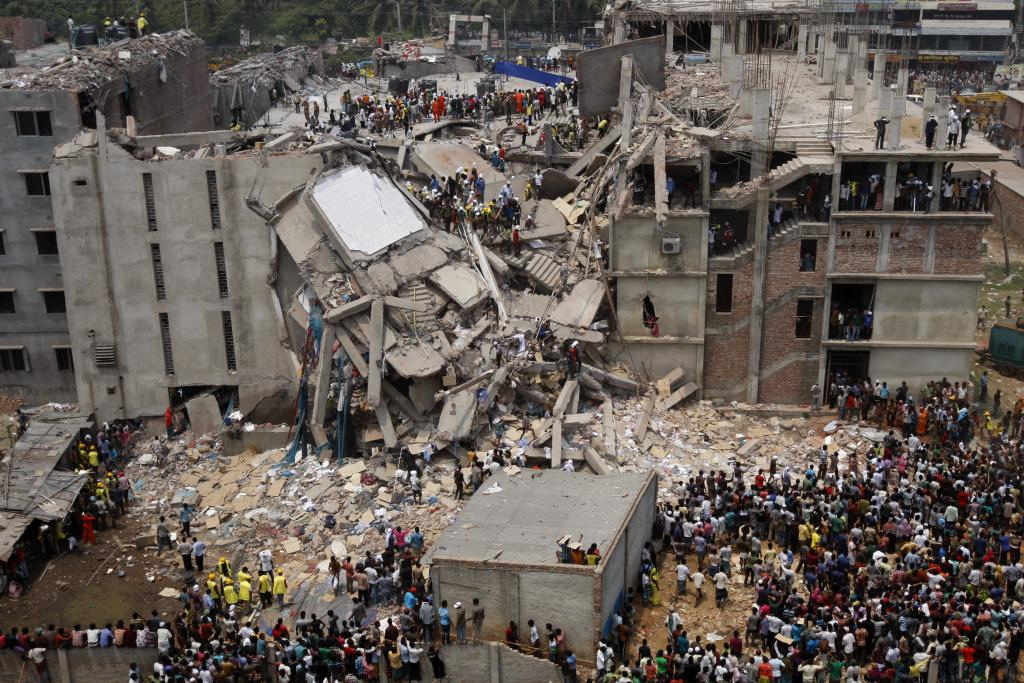April 24 marks three years since the collapse of the Rana Plaza complex in Dhaka, Bangladesh, causing the death of 1,134 garment workers. Charities, journalists, and corporations alike recognized the disaster as an eventuality of sorts: with the collective voice of those in the know being devastated at the loss, but not as shocked that the state of our clothing supply-chains could lead to such massive death and destruction.
While the fast fashion and clothing industries don’t tend to rank highly in the field of moral good, it is distressing that it took the death of hundreds of garment workers to ignite the conversation about garment production transparency and modern day slavery in fashion. And still, three years on from Rana Plaza, seemingly interminable garment worker injustices continue to form the backbone of so many brands: 71% of major clothing companies believe modern day slavery occurs at some point in the making of their product, while just under 50% of brands can’t even name the factories where their garments are made. And if H&M, who rate fairly well on the transparency index, can pump out 1000 tons of clothes every 48 hours, more than a moment must be spared for just how many clothes there are in the world, and how many of them have been produced unfairly, and inhumanely.
We can’t start to tackle exploitation until we can see it.
But there is change afoot. #WhoMadeMyClothes is the simple, grassroots call to arms led by the group Fashion Revolution in response to the Rana Plaza collapse. Every year consumers are asked to take to social media, photographing the label of their clothes and tagging it with the aforementioned hashtag, asking brands who made their clothes, seeking the ultimate goal of fully transparent and fair supply chains for all fashion companies.
“We want to see an increasing number of brands make their supply chains more transparent, because we can’t start to tackle exploitation until we can see it,” Carry Somers, founder and director of Fashion Revolution, told i-D. “Every stakeholder in the fashion supply chain must become responsible and accountable for their actions and impacts. It’s not just the brands and retailers…it’s the myriad of other stakeholders along the chain too.”
“Private and White label manufacturers are responsible for a huge amount of what we buy on the high street, Li & Fung, for example, supplies 40% of all clothing sold in the U.S, yet most people are unaware of their existence and so there is little public pressure on them. Not one of these companies publishes a list of their suppliers or vendors, nor do they publish any social and environmental sustainability reports,” Somers concludes.
Honesty and accountability is what Fashion Revolution is asking from clothing companies, and the organization is urging us as consumers to ask for the same. The revolutionary thing about the #WhoMadeMyClothes campaign is that it is a single phrase which cuts to the root of the problem — asking who, from farmers to seamers, actually had a hand in making the clothes that just appear on the racks at the front of our favorite shops.
And while some brands are responding, and many sustainable and fair trade brands are genuinely making and keeping their promises, (see places like Rapanui, Zady, The Revolution, People Tree, Mat and Nat, Veja, Birdsong, Patagonia, Stella McCartney as stellar examples) the drive for newer, and cheaper, clothes is as rife as ever. “Consumer’s behavior just isn’t changing,” Rachel Manns, Ethical Fashion Photographer, told us. “Fast fashion is rife, and wear once throw away culture doesn’t seem to be slowing any time soon. [The Fashion Revolution] is about getting the brands to seriously clean up their acts, just as much as it is about getting consumers to make choices that are better for people and the planet.”
The true Fashion Revolution will come when ethical fashion is no longer a niche market.
A buyer who works with some of the leading high street brands, and wishes to remain anonymous, told i-D that they can see consumer’s need for cheaper, faster fashion actually impacting suppliers and factories directly. “The high street chains are fighting a very competitive price battle and the cheaper they get the more volume they can sell. Products that five years ago were selling for £30 ($43) to £50 ($71) are now retailing for £20 ($28) to £30 ($43). This price drop is driven straight back to the suppliers and factories. Consumers want added value/premium/up styled garments for cheaper than ever before! There is only so much a factory can squeeze the costs before they have to start cutting corners. And buyers at the end of the day, just want their target prices…” It’s a bleak prognosis, especially in lieu of so much positivity from those fighting for fairness, although what’s notable here is that it is the suppliers and producers, and certainly not the brands, who are absorbing the lower price higher output demands put on today’s fast fashion system.
The true Fashion Revolution will come when ‘Ethical Fashion’ is no longer a niche market. The future should aim for consumers to be shopping for fashion that just so happens to be ethical. All aspects of production for all companies must be regulated, transparency demanded and fairness for workers and the environment held tantamount to design and price, and above profit. Ethical companies and #WhoMadeMyClothes are garnering change year on year, from consumer consciousness, to pressuring brands, to pushing those powerful enough in government to alter garment, trade and work legislation to sanction those guilty of perpetuating injustice across supply chains. But in order for the injustices which surround the clothes we consume so freely to end, we as shoppers must first become aware of the humans behind our wardrobes, and remember them every time we see something we ‘need.’
Credits
Text Tom Rasmussen
Photography via WikiCommons
